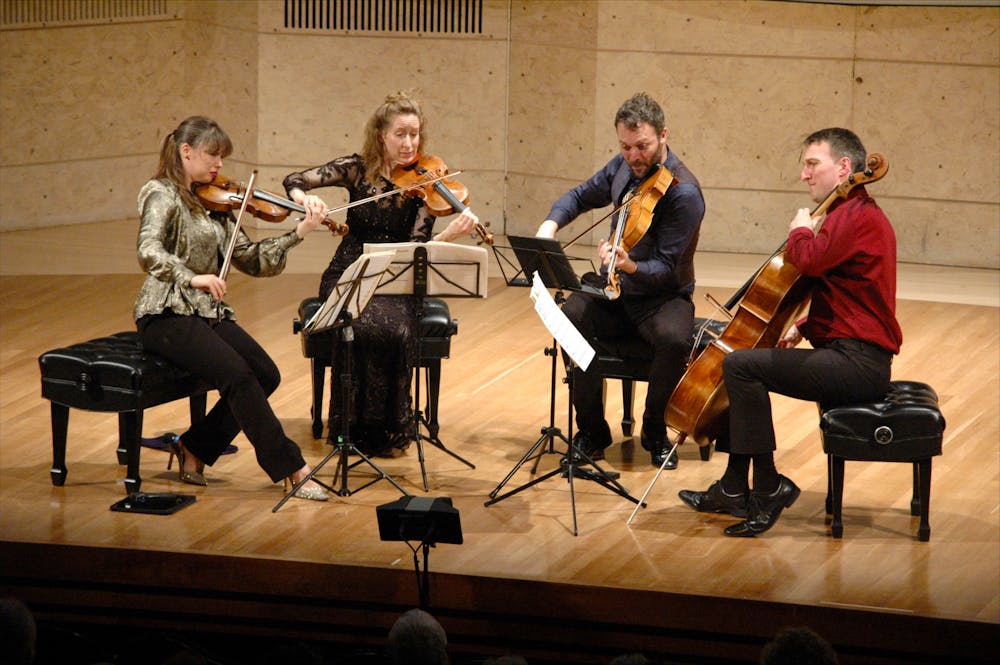The Heath Quartet has a longstanding relationship with Middlebury. The April 28 concert marked its tenth appearance with the Performing Arts Series. Previously, the British group was the series’ first ever quartet in residence, performed a full Bartok cycle and played a six-concert Beethoven cycle (although the last two were cut short by the Covid-19 pandemic.)
For this Sunday afternoon performance, the group began with an arrangement of J.S. Bach’s organ chorale prelude “O Mensch, bewein’ dein’ Sünde groß,” during which the unified resonance was striking. The quartet compressed its dynamic range and seemed to focus on using the varied textures of the instruments to highlight the multiple polyphonic voices in Bach’s writing. Ultimately, the musicians delivered a faithful interpretation that blended the four instruments into one, à la organ.
“We’re living in the golden age of the string quartet,” retired Professor of Music Larry Hamberlin said. “There are more great quartets right now than there have ever been in the past, but the Heath are really one of the top ones I think.”
Hamberlin also noted the distinct characters of the four instrumentalists, describing that the Heath Quartet has an uncanny ability to shift between presenting a unified voice and highlighting the musicians’ separate personalities.
“Haydn basically gave us our profession,” violist Gary Pomeroy said before the quartet embarked on the Austrian Joseph Haydn composer’s “String Quartet Op. 50 No. 1” in B-flat Major. It was immediately clear that this piece required four distinct personas.
The musicians organically split into groups of two and three and passed the effervescent themes between each other, with Pomeroy managing the textural blending, and cellist Christopher Murray grounding the work through Haydn’s simple yet poignant bass line. Hamberlin told The Campus that the most important part of Haydn’s music was his comedy, and the Heath surely did this justice.
In the Adagio, the program notes read: “one has a sense that Haydn chooses to mask his own seriousness.” Violinists Sara Wolstenholme and Juliette Roos embodied these sentiments as they emphasized the minute gradations of color and texture in the melody to paint a sonic portrait that was simultaneously hyper-serious and comical.
The third movement required radical shapeshifting, as the Minuet is written with enough interpretative freedom to reveal the performer’s intentions. In a repeated motif in which the violin skips down the scale in an abbreviated staccato, Wolstenholme lavishly milked the rubato, reminding the audience of the experimental nature of this 18th-century quartet. Murray and Pomeroy were both laughing as they enthusiastically followed Wolstenholme’s cues and enjoyed the airy humor of the movement.
That energy continued into the final movement, which stole the show. Haydn’s characteristic humor is most evident near the end when he wrote a false ending. The movement cadences at the end of a coda and is followed by two bars of silence, leading the listener to think that it is over. The quartet leaned into the hyperbole and lifted their bows high… they got the audience hook, line and sinker. As the abbreviated applause transformed into chuckles all around the hall, the musicians raced to the end and provided an even grander finish.
In addition to relishing the oeuvres of well-established composers, the quartet enjoys championing lesser-known works. It did just this in the second half of the program with Dutch composer Henriëtte Bosmans’ 1927 String Quartet.
“She was quite a character by all accounts,” Wolstenholme announced before beginning the piece. “During the Second World War, she marched into a Gestapo headquarters in Amsterdam and managed to secure the release of her 83-year-old Jewish mother.”
The piece was ripe with colors and influences from a variety of sources. The high strings brought out the ethereal harmonies, while Murray’s cello rumbled underneath. The quartet collectively took an understated approach, emphasizing the delicacy of the piece’s harmonic content, which vaguely recalled the impressionistic French school of Debussy and Ravel. This was supplanted with emotional tension that built throughout the second movement; the group unified once again to bring out Bosmans’ schmaltzy, longing melodies. The third movement was a smorgasbord of unique rhythms and emotions that mixed impressionist influences with fascinating expressionist ideas. Bosmans’ dramatic side was clearly a favorite of the musicians.
Before its next piece, the quartet announced the surprise addition of “Sarabande & Fugue for String Quartet” by Russian Composer Anatoly Lyadov. In a concert program that darted through the centuries, presenting esoteric portraits of each, this six-minute piece echoed Baroque polyphonies with a certain lusciousness characteristic of the 19th-century Russian composers — a warm addition that tied together the daring program.
Composer Erich Korngold, an Austrian child prodigy, came to fame after moving to Hollywood in 1934. He was responsible for some of the most influential film scores of the 20th century, including “A Midsummer Night’s Dream” (1935) and “The Adventures of Robin Hood” (1938). After an illustrious Hollywood career, however, Korngold returned to writing concert music and seemed to amalgamate many musical styles and developments of the first half of the 20th century. The “String Quartet No. 3” in D Major — the final piece for the quartet — was taken from these compositions.
The quartet brought out tension and pain during the first two movements by leaning into the dissonant harmonies that clashed heavily with each other. The violins cried out in higher registers, while the viola and cello supported them with furious technical passages. The composition’s fundamental struggle is between cinematic themes and dissonant, near-modernist motifs. The Heath Quartet portrayed both with equal sincerity, creating two distinct sound worlds and pitting them against each other. Is this a high-brow satire of film music on Korngold’s part, or does his Hollywood experience unconsciously sneak into his compositions, as he writes soaring melodies that could be transplanted into a romance movie?
To conclude the piece, the quartet sprinted through the fourth movement at an unconventionally fast tempo, and Murray’s cello — which had played a self-effacing supporting role up until this point — finally shone in chords that rang throughout the hall. The constant modulations raced to a close, as the quartet (clearly enjoying the perpetual shifting of worlds) showcased both sides of Korngold with interpretive clarity.
After a four-year hiatus from Middlebury, the Heath Quartet’s unconventional program highlighted its willingness to juxtapose mainstays of the repertoire with riskier works.
As everyone exited the audience, someone remarked: “Korngold! Movie music — who knew it could be so good?”

Tejas Srinivasan '24 (he/him) is an Editor at Large.
Originally from Cincinnati, Ohio, Tejas previously served as an opinion editor. He spent his junior year in London at King’s College. Outside of The Campus, he also hosts a podcast called Cultural Mixtapes which he started in the summer of 2022. Tejas is an English Major, on the literature track, with a music minor.




